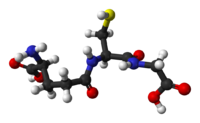
Photo from wikipedia
Increased consumption of fructose-rich beverages has emerged as an important risk factor for development of hepatic steatosis, type 2 diabetes and metabolic syndrome. As is well-known, fructose robustly stimulates de… Click to show full abstract
Increased consumption of fructose-rich beverages has emerged as an important risk factor for development of hepatic steatosis, type 2 diabetes and metabolic syndrome. As is well-known, fructose robustly stimulates de novo lipogenesis in vivo; but how this occurs is less clarified and may involve multiple mechanisms. To determine the mechanism of fructose-induced hepatic steatosis and associated metabolic disease, we fed mice with chow diet and 30% fructose in drinking water. Fasting blood glucose level was elevated and insulin sensitivity was impaired in fructose fed group. Also, mice fed with fructose showed exaggerative lipid accumulation in the liver. To find out how fructose induced hepatic steatosis, we performed liver proteomic analysis following fructose fed. Compared with chow fed, Fructose fed significantly increased malic enzyme 1 (ME1), which is NADP-dependent and responsible for NADPH generation. Consistently, the ratio of NADPH/NADP+ in liver was increased by fructose fed, suggesting that fructose increased hepatic redox status. NADPH performed as a hydrogen donor for the synthesis of fatty acids, nucleic acids, etc. We also found that the multiple metabolites depending on NADPH production was dramatically enriched in our metabolome analysis. Then, we use selective ME1 inhibitor to decrease NAPDH production and redox status. The accumulation of triglyceride (TG) in primary hepatocytes by fructose was dose-dependently reduced by ME1 inhibitor. Similarly, the increasing of intracellular TG accumulation and NADPH/NADP+ ratio by fructose was inhibited upon ME1 knockdown by the application of siRNA. Taken together, our preliminary results suggested that ME1 mediated cytosolic redox status might play an important role in fructose induced hepatic steatosis and associated metabolic disease. Disclosure H. Jiang: None. J. Li: None.
Journal Title: Diabetes
Year Published: 2020
Link to full text (if available)
Share on Social Media: Sign Up to like & get
recommendations!